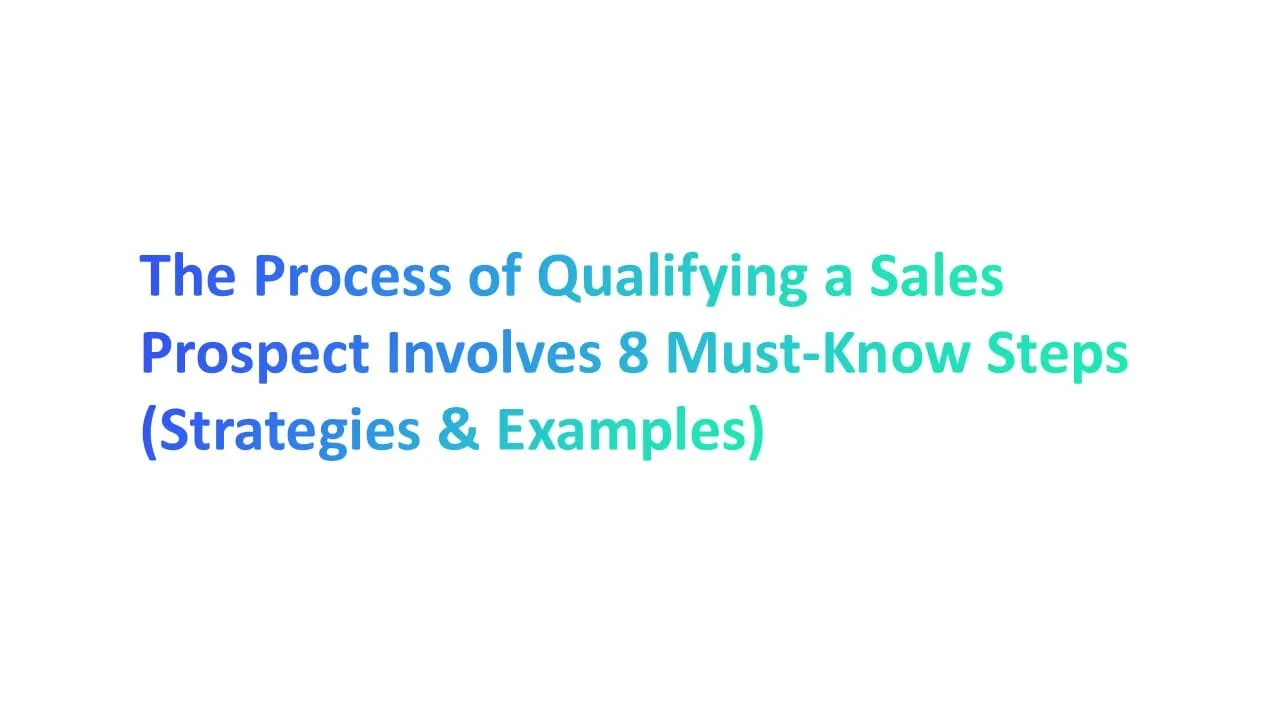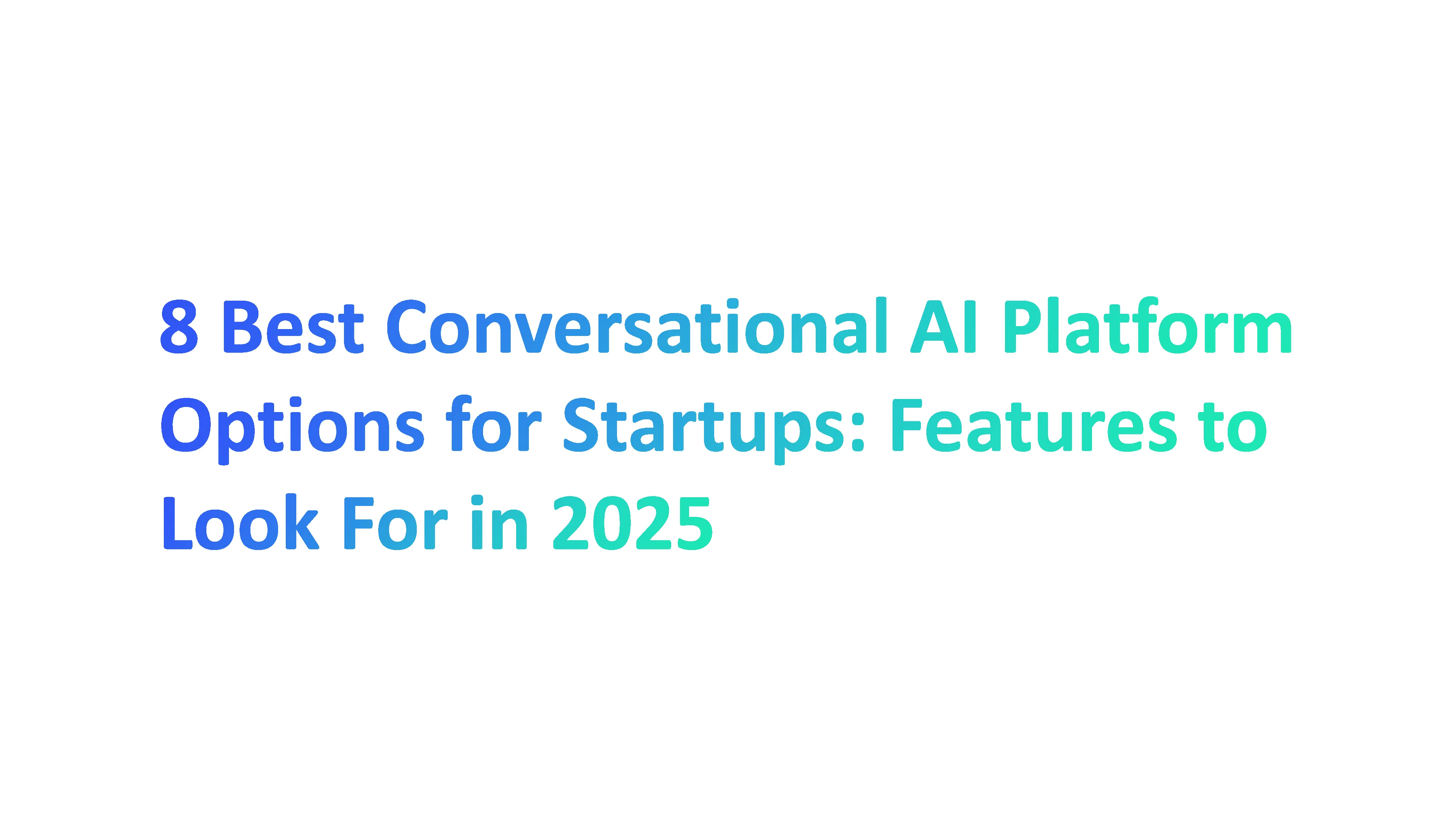Lead Generation is the lifeline of any business, especially as we step into 2025's dynamic and competitive market environment.
Did you know companies with robust lead generation strategies witness a 50% increase in sales-ready leads, according to HubSpot? It’s not just about finding leads—it’s about attracting high-quality prospects that convert into loyal customers.
This guide provides practical strategies to enhance your lead-generation efforts. Whether you're using inbound marketing, refining landing pages, or utilizing AI insights, these tips are crafted to help you succeed.
Get ready to attract the leads your business needs!
What is Lead Generation?

Lead generation is the process of finding people who may be interested in your product or service. These people are called “leads.”
Businesses use the lead generation tool, to attract potential customers and turn them into buyers. Without it, growing a business becomes very hard.
What are Leads?
Leads are people who show interest in what your business offers. For example, if someone fills out a form on your website to learn more about your service, they are a qualified lead now.
Leads can come from different places, such as:
- Social media platforms like Instagram or LinkedIn.
- Landing pages where people sign up for free guides or offers.
- Ads that direct people to your website.
There are two main types of leads:
Marketing Qualified Leads (MQLs): A marketing qualified lead often interacts with your content but may need more nurturing before making a purchase.
Sales Qualified Leads (SQLs): A sales qualified lead is someone ready to engage with your sales teams after showing strong purchase intent.
Why is Lead Generation Important in Growing Your Business
Generating leads is critical for any business. Let’s explore why leads matter so much:
1. Leads Represent Future Revenue Potential
Think of leads as seeds for future sales. When you have more leads, you have more chances to close deals and earn revenue.
According to a report by HubSpot, businesses with strong lead generation efforts see 50% more sales-ready leads.
2. Help Identify Market Demand
Leads give you valuable insights into what your potential customers want. For example, if many leads show interest in a specific product, you know there’s high demand for it. This helps you adjust your marketing and product strategies.
3. Cost-Efficient Marketing Feedback Loop
Collecting lead information helps you understand what works in your marketing campaigns. Instead of wasting money on ads that don’t connect, you can focus on what attracts your target audience. This saves money and improves results.
4. Strengthens Brand Positioning
When people consistently see your brand during the lead generation process, it builds trust and build brand awareness further.
Over time, prospective customers say your brand becomes their go-to solution. Strong brand positioning also attracts high-quality leads.
5. Boosts Investor Confidence
Investors want to see growth potential. A steady pipeline of leads shows that your business is expanding and has future opportunities. It’s a powerful way to build trust with stakeholders.
A strong lead generation strategy helps businesses focus on attracting high-quality leads that align with their goals.
"Want to Build Better Campaigns? Start with Alore’s User-Friendly Dashboard!"
What is the Lead Generation Process?

First, you need to know who your ideal customers are. What do they like? Where do they spend time online? For example, if your product helps small businesses, your target audience might be business owners looking for solutions.
Next, create valuable content, as people love useful content. This can be blogs, videos, or even free guides. The goal of relevant content is to grab attention. For example, a bakery might create a recipe ebook to attract baking enthusiasts.
Then, use the right lead generation tactics and tools to help you collect contact information from interested people. For example, landing pages and lead capture forms make it easy for visitors to sign up. According to HubSpot, businesses using landing pages see a 55% increase in leads.
Use social media platforms like LinkedIn and Instagram to find leads. Post helpful tips, run ads, or share stories about your product or service.
Not all leads are ready to buy right away. Use lead scoring systems to see who’s interested now and who needs more time. Send follow-up emails or offer discounts to keep them engaged.
Types of Lead Generation

1. Inbound Lead Generation
Attract leads by creating valuable content such as blogs, eBooks, and webinars. Search engines, social media, and email marketing bring prospects to you instead of you chasing them.
2. Outbound Lead Generation
Proactively reach out to potential leads through methods like cold calling, direct emails, or paid ads. This approach targets specific audiences directly, often leading to quicker responses.
3. Content Marketing Lead Generation
Use tailored content like guides, case studies, or videos to address customer pain points. High-quality content builds trust and attracts leads who resonate with your brand.
4. Social Media Lead Generation
Platforms like LinkedIn, Instagram, and Facebook enable businesses to capture leads through targeted ads, polls, and engaging posts. Features like "Swipe Up" links or lead forms simplify the process.
5. Referral Lead Generation
Leverage happy customers or partners to refer new leads to your business. Referral programs with incentives like discounts or rewards can boost word-of-mouth marketing.
6. Event-Based Lead Generation
Participate in or host events, webinars, or trade shows. These settings help you interact with potential leads directly and gather their information for follow-ups.
How to Generate Leads
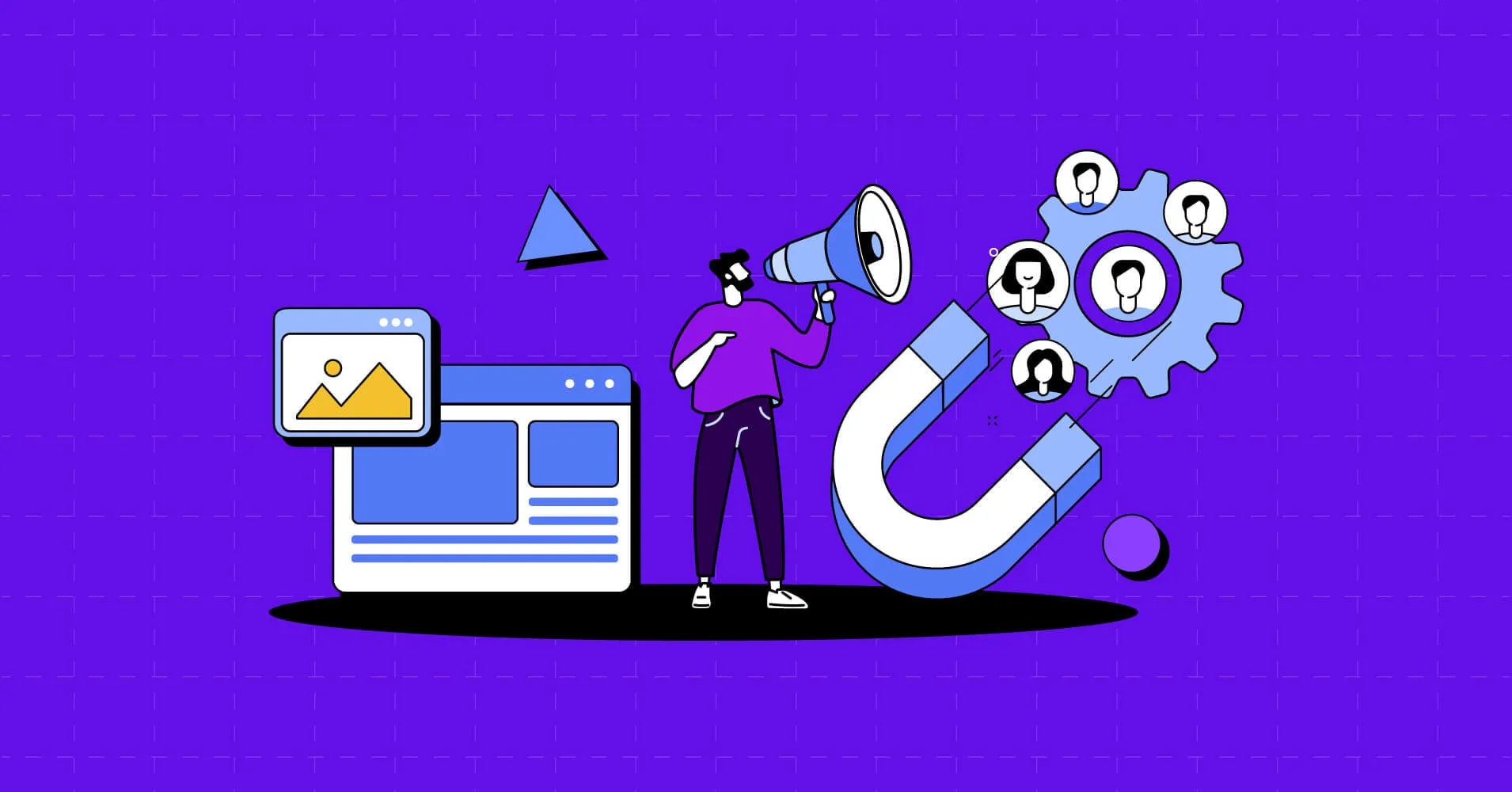
1. Know Your Audience
To generate leads, you first need to understand who you are trying to reach. These people are your target audience.
Ask yourself:
- What do they need?
- What problems are they facing?
For example, if you sell sports shoes, your audience might be runners or gym-goers. Learning about them helps you create messages they care about.
Use tools like surveys or social media polls to gather lead information. This way, you attract people who truly want your product or service.
2. Leverage Interactive Content
Interactive content keeps people engaged. It could be quizzes, calculators, or even surveys.
For example, a skincare company might create a quiz: "What’s Your Skin Type?" People who complete the quiz share their contact details, making them potential leads.
Why it works:
- Interactive content is fun and engaging.
- It helps you collect lead capture forms without being pushy.
According to a study by Content Marketing Institute, interactive content generates twice as many leads as static content. Give it a try!
3. Optimize Landing Pages for Conversions
A landing page is a web page designed to collect lead information. When someone clicks on your ad, they’re taken to a landing page.
To make it effective:
- Keep it simple and clear.
- Add a strong call-to-action like "Sign Up Now!"
- Include a form to capture high-quality leads.
Research shows that businesses using optimized landing pages see up to 55% more conversions. Don’t forget to use visuals and testimonials to build trust.
4. Use Chatbots for Lead Collection
Chatbots are like virtual assistants for your website. They pop up to help visitors find what they need and collect their information.
Here’s how chatbots can help:
- Engage visitors instantly: A chatbot can greet people when they visit your site, just like a helpful store clerk.
- Ask simple questions: Chatbots can ask for the visitor’s name, email, or their needs.
- Work 24/7: Unlike humans, chatbots never sleep. They collect lead information even when your team is offline.
For example, a chatbot on an online clothing store might ask, “Looking for casual wear or formal wear today?” This makes the experience personal and gathers details about potential customers.
5. Run Targeted Social Media Campaigns
Social media platforms like Facebook, Instagram, and LinkedIn are great for generating leads. These platforms allow you to run targeted campaigns that reach the right audience.
Here’s how to make it work:
- Know your audience: Use data to understand your target audience and what they like.
- Create engaging ads: Use bright visuals, catchy headlines, and clear calls to action like “Sign Up Now!”
- Include a lead capture form: Direct people to a landing page where they can fill out a form to learn more.
According to a report by Statista, 80% of marketers say social media helps increase lead quality. For example, a local gym might use Instagram ads to promote free trials, targeting fitness enthusiasts in the area.
How to Qualify Leads

1. Implement Advanced Lead Scoring Models
Lead scoring is a system to rank leads based on their likelihood to become customers. It uses points to measure how "ready" a lead is to make a purchase.
Why it’s important: Lead scoring helps your sales team focus on high-quality leads. This system can improve lead quality and ensures your marketing efforts target the right audience.
How to do it:
- Assign points for actions: For example, give points to a lead who visits your website, clicks on an email, or downloads a guide.
- Set thresholds: Define the score that qualifies a lead as “sales-ready.” Leads who cross this score should be sent to your sales team.
- Use tools: CRM platforms like HubSpot or Salesforce have built-in lead scoring systems. They automate the process, saving time and reducing errors.
Let’s say a lead visits your landing page, downloads a whitepaper, and signs up for a webinar. These actions can add up to a high score, marking the lead as ready for follow-up.
2. Leverage AI-Powered Predictive Analytics
AI-powered predictive analytics uses machine learning to analyze lead behavior and predict future actions. It identifies leads most likely to convert based on past data.
Why it’s important: AI makes qualifying leads faster and more accurate. It analyzes large amounts of data that humans can’t process as quickly. Businesses using AI for their lead quality and generation efforts report a 30% increase in conversion rates, according to Salesforce.
How to do it:
- Gather lead data: Collect data like website visits, email responses, and social media interactions.
- Use AI tools: Platforms like Marketo and Drift analyze this data to predict which leads are likely to buy.
- Segment leads: AI can group leads by behavior, such as “ready to buy” or “needs nurturing.” This helps your marketing team focus their strategies.
Imagine AI noticing that leads who view your pricing page twice in a week are more likely to buy. Your sales team can prioritize reaching out to these leads.
3. Adopt the MEDDIC Framework
The MEDDIC framework is a step-by-step process that helps businesses qualify leads. It stands for Metrics, Economic Buyer, Decision Criteria, Decision Process, Identify Pain, and Champion.
Why it’s important: The MEDDIC framework ensures you ask the right questions to understand a qualified lead’s needs and readiness to buy. According to Gartner, using structured qualification methods like MEDDIC can shorten sales cycles and improve sales qualified lead and conversion rates.
How to do it:
- Metrics: Find out the measurable value your product or service offers. For example, how much time or money will it save the customer?
- Economic Buyer: Identify the person who makes the final decision about the purchase.
- Decision Criteria: Learn what factors are most important to the buyer, like cost, quality, or delivery time.
- Decision Process: Understand how the buyer will decide, including steps like approvals or meetings.
- Identify Pain: Find out what problem the lead is trying to solve. Leads with clear pain points are often the easiest to qualify.
- Champion: Build a relationship with someone inside the organization who can advocate for your product or service.
Imagine a company looking for a software tool to manage their sales and marketing teams. By asking MEDDIC questions, you can determine their pain points, their budget, and who will decide to buy the tool.
4. Utilize Behavioral and Predictive Scoring
Behavioral and predictive scoring involve analyzing a lead’s actions and using data to predict their likelihood of making a purchase.
Why it’s important: These methods use real-time data to qualify leads accurately.
Leads who engage with your emails, visit your landing pages, or download your lead magnets are more likely to be ready for sales. Predictive scoring uses advanced tools like AI to analyze patterns, saving time and improving accuracy.
How to do it:
- Track behaviors: Monitor actions like email clicks, website visits, and social media engagement.
- Assign scores: Use a lead scoring system to give points for each action. For example, downloading an eBook might earn 10 points, while viewing the pricing page might earn 20 points.
- Use predictive tools: Platforms like HubSpot and Marketo use AI to predict which leads are most likely to convert.
- Segment leads: Group leads into categories such as “hot” (ready to buy) and “cold” (needs nurturing).
For example, if a lead visits your product or service page multiple times, that behavior suggests strong consumer interest. Behavioral scoring will flag them as a high-priority lead for your sales team.
"Track, Analyze, and Improve—Experience Alore’s Drip Campaign Features Now!"
11 Proven Lead Generation Strategies
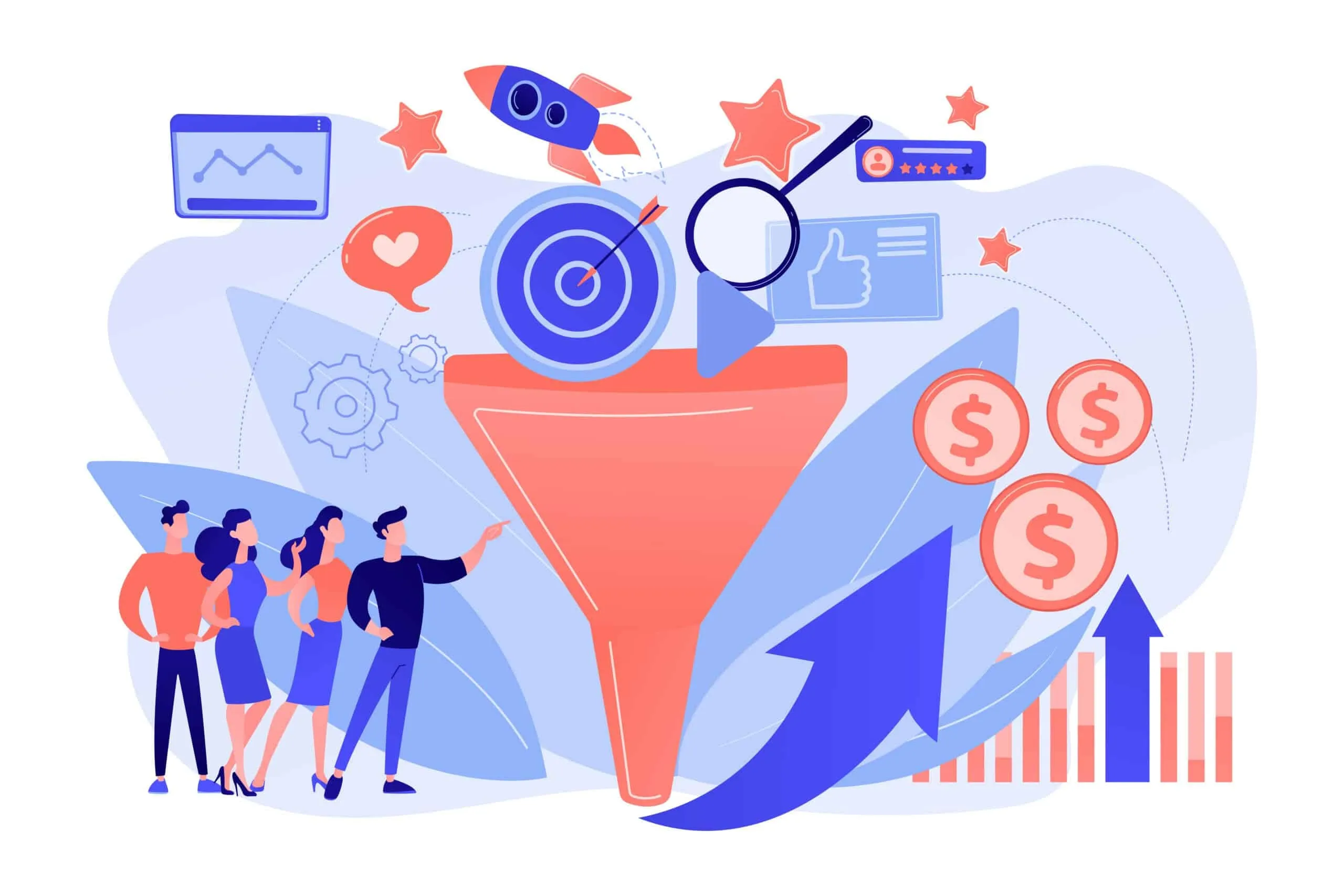
1. Optimize Your Website for SEO
SEO, or Search Engine Optimization, is a way to make your website easier to find on search engines like Google. When people search for products or services like yours, you want your website to show up at the top of the results.
How to do it:
- Use Keywords: Add terms like “leads generation” and “target audience” to your website content naturally. This helps search engines understand your website.
- Write Clear Titles: Create titles that tell readers exactly what they’ll learn, like “How to Generate High-Quality Leads.”
- Make it Mobile-Friendly: Many people use their phones to browse. Ensure your site looks great on any device.
- Improve Page Speed: A fast website keeps visitors happy. Tools like Google PageSpeed Insights can help you identify problems.
Websites optimized for SEO attract more visitors. These visitors are likely to become potential leads for your business.
2. Use Email Marketing Campaigns
Email marketing is sending messages to people’s inboxes to keep them engaged with your brand. It’s a powerful way to connect with potential customers.
How to do it:
- Build a List: Collect emails through landing pages or signup forms. Offer something valuable, like a free guide, in exchange for their email address.
- Personalize Messages: Address people by their names and send emails tailored to their interests.
- Use Clear Calls-to-Action (CTAs): Add phrases like “Learn More” or “Sign Up Now” to guide readers.
- Measure Results: Use tools like Mailchimp or HubSpot to track open rates and clicks.
Email marketing campaigns generate 4 times more leads than social media campaigns, according to Statista. They are cost-effective and help build strong relationships with qualified leads.
"Personalize Every Email with Alore’s Advanced Warm-Up Settings! Sign Up To Know More"
3. Leverage Social Media Ads
Social media ads are paid advertisements shown on platforms like Facebook, Instagram, and LinkedIn. These ads help you connect with your target audience directly.
How to do it:
- Know Your Audience: Before creating ads, understand who you want to reach. For example, a local bakery might target young adults in the area who love desserts.
- Create Engaging Content: Use eye-catching visuals and clear messages. Add a strong call to action like “Shop Now” or “Learn More.”
- Use Targeting Features: Platforms like Facebook let you target people based on their location, interests, or age. This ensures you reach the right people.
- Track Performance: Monitor clicks, views, and conversions. Tools like Facebook Ads Manager help you see what works and what doesn’t.
According to Statista, businesses using social media ads see 73% more conversions. These ads help you collect lead information and direct people to landing pages to sign up or make a purchase.
4. Host Webinars and Live Events
Webinars are online sessions where you share knowledge or showcase your product. Live events can be in-person or virtual gatherings to connect with your audience.
How to do it:
- Choose a Topic: Pick a subject your audience cares about. For example, a fitness coach might host a webinar on “5 Easy Home Workouts.”
- Promote the Event: Share the event on your website, social media platforms, and through email marketing campaigns.
- Collect Sign-Ups: Use a lead capture form to collect attendees’ names and emails.
- Engage During the Event: Answer questions and share helpful tips. This builds trust with your audience.
- Follow Up: After the event, email attendees with additional resources or offers.
Webinars and live events allow you to connect personally with potential leads. They’re a great way to demonstrate expertise and gather high-quality leads who trust your brand.
5. Offer Gated Content
Gated content is any valuable resource that people can access only after providing their contact information, like an email address. Examples include eBooks, guides, and exclusive videos.
How to do it:
- Create Valuable Resources: Write a free guide or make a video that solves a common problem for your audience. For example, a fitness trainer could offer an eBook called “7 Easy Workouts at Home.”
- Use a Landing Page: Design a page where visitors can fill out a lead capture form to get the content.
- Promote Your Offer: Share the content on social media, in email campaigns, or through ads.
People are willing to share their details for something valuable. Gated content helps you collect high-quality leads who are genuinely interested in your product or service.
6. Launch Pay-Per-Click (PPC) Campaigns
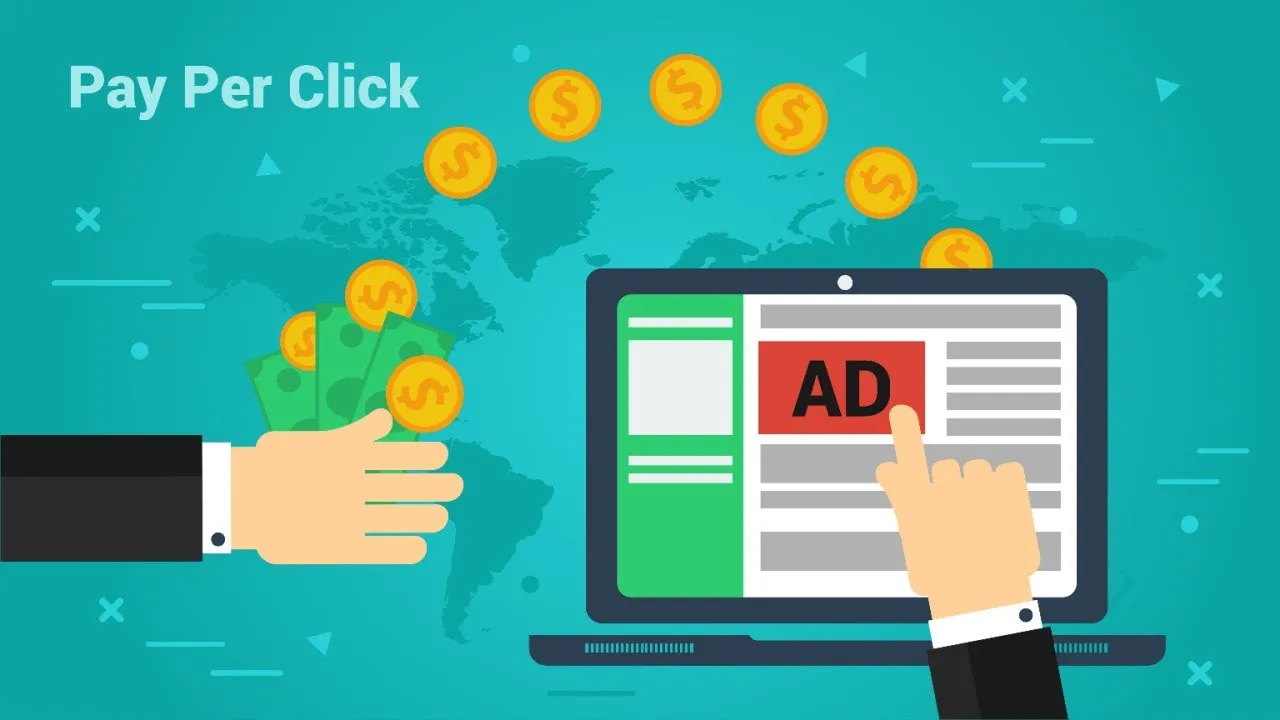
PPC campaigns are ads you pay for every time someone clicks on them. They often appear on search engines like Google or social media platforms.
How to do it:
- Choose Keywords: Use terms like “leads generation” and “target audience” that people search for.
- Set a Budget: Decide how much you’re willing to spend per click. Start small and adjust as you see results.
- Write Compelling Ads: Make sure your ad has a clear message and a strong call to action, like “Download Free Guide Now.”
- Use a Landing Page: Direct clicks to a page designed to capture lead information quickly and effectively.
- Analyze Results: Use tools like Google Ads to track clicks, conversions, and costs.
PPC campaigns let you reach potential leads instantly. According to HubSpot, businesses using PPC see a 200% return on investment (ROI).
7. Set Up Referral Programs
A referral program rewards your existing customers for bringing in new people. For example, a coffee shop might offer a free drink to customers who refer a friend.
How to do it:
- Choose Your Reward: Decide what you’ll give. It could be a discount, free product, or exclusive access to services.
- Make It Easy: Create a simple way for customers to refer others, like a unique referral link or a sign-up form.
- Promote the Program: Share it on your website, social media platforms, and email marketing campaigns.
People trust recommendations from friends and family. Referral programs not only attract potential leads but also strengthen loyalty among existing customers. According to Nielsen, 92% of people trust referrals from people they know.
8. Use Lead Magnets
A lead magnet is something valuable you offer for free in exchange for contact information. Examples include free trials, checklists, or exclusive eBooks.
How to do it:
- Understand Your Audience: Think about what your target audience wants or needs. For example, a travel agency could offer a “Top 10 Vacation Destinations” guide.
- Design an Appealing Offer: Use bright visuals and clear titles to make it stand out.
- Use a Landing Page: Direct visitors to a page where they can provide their email to access the content.
Lead magnets help you capture qualified leads who are genuinely interested in your product or service. A well-designed lead magnet increases your chances of converting visitors into customers.
9. Engage in Content Marketing
Content marketing means creating helpful and interesting material for your audience. Examples include blog posts, videos, and infographics.
How to do it:
- Write Blogs: Share tips, guides, or success stories that solve problems for your audience. For instance, a skincare brand might write a blog on “How to Prevent Dry Skin in Winter.”
- Create Videos: Short videos are engaging and easy to understand. Use them to show how your product or service works.
- Offer Free Downloads: Provide guides, templates, or checklists as lead magnets to collect contact details.
Content builds trust. When people find your material useful, they are more likely to become qualified leads.
10. Do Networking and Partnerships
Networking involves connecting with other businesses or individuals to grow your reach. Partnerships allow you to team up with others to share resources or audiences.
How to do it:
- Join Industry Events: Attend conferences or trade shows to meet potential customers and business owners.
- Collaborate with Others: Partner with a complementary business. For example, a gym might team up with a health food store for a joint promotion.
- Engage on Social Media: Comment on posts, share ideas, and start conversations with industry leaders.
When you build relationships through marketing channels, you expand your network. Partnerships help you tap into new audiences and generate high-quality leads faster.
11. Tap into LinkedIn Outreach
LinkedIn outreach is using LinkedIn to connect with professionals in your field. It’s especially effective for B2B businesses.
How to do it:
- Optimize Your Profile: Make sure your profile looks professional and highlights what you do.
- Connect with Your Audience: Send personalized connection requests to people who might benefit from your services.
- Share Valuable Content: Post helpful articles or insights that show your expertise.
- Use LinkedIn Messages: Reach out directly to leads with a polite and personalized message.
LinkedIn is built for networking. It allows you to reach decision-makers directly and find potential leads quickly.
Tips to Run Lead Generation Campaigns
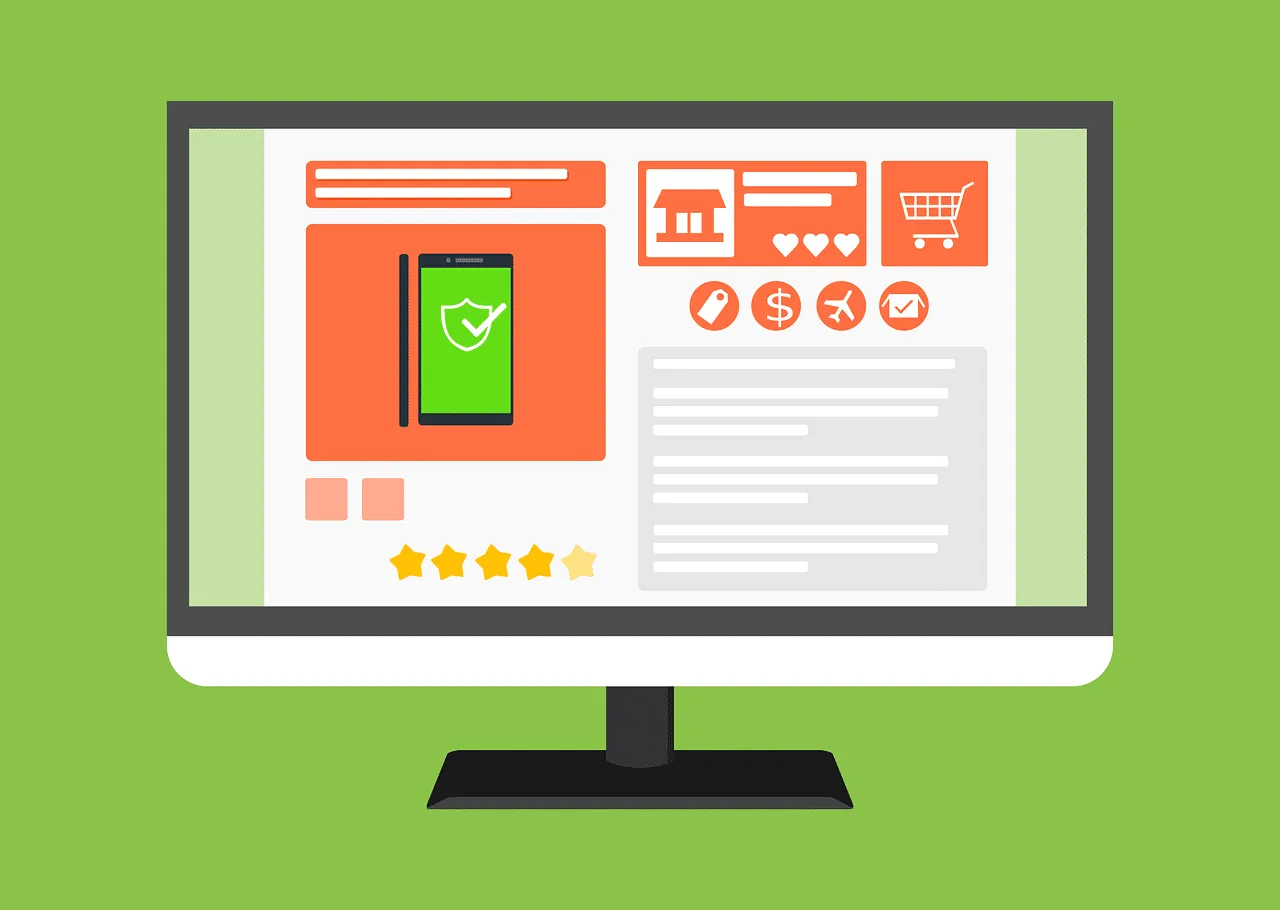
A well-planned lead generation campaign uses targeted strategies to attract high-quality leads. Below are the tips to effectively run your campaigns:
1. Define Clear Goals and KPIs
Goals are what you want to achieve. KPIs (Key Performance Indicators) are numbers that help you track success. Together, they keep your marketing campaign on the right path.
Without clear goals, your campaign can feel directionless. For example, do you want to get more leads, improve lead quality, or boost sales? Setting KPIs ensures you know if your efforts are working.
How to implement it:
- Be Specific: Instead of saying, “We want more leads,” set a goal like, “We want 100 new leads this month.”
- Choose KPIs: Use KPIs like conversion rates, cost per lead, and landing page traffic to measure success.
- Track Your Progress: Tools like Google Analytics or HubSpot can help monitor your goals.
Example: Imagine running a campaign with a goal to attract 50 qualified leads in 30 days. You could use landing pages and track the number of form submissions as a KPI.
2. Personalize Your Outreach
Personalizing outreach means tailoring your message to fit each customer. Instead of sending the same email to everyone, customize it based on their needs.
People respond better to personalized communication. According to Salesforce, personalized emails improve click-through rates by 14%. Personalization makes your leads feel valued and increases your chances of success.
How to implement it:
- Segment Your Audience: Divide your target audience into groups based on interests, location, or behavior.
- Use Names and Details: Address your leads by name and refer to their specific interests.
- Leverage Data: Use tools like CRM software to track customer data and craft relevant messages.
- Focus on Timing: Send emails or messages when your leads are most likely to respond.
Example: If a lead downloaded a guide on social media marketing, send them an email offering tips on how to run better social media ads.
3. Test Multiple Lead Magnets
Lead magnets are free resources or offers that you provide in exchange for a lead’s contact information. Examples include eBooks, templates, webinars, and discount codes.
Not every lead is attracted by the same thing. Some may download a free checklist, while others prefer an interactive tool. Testing multiple lead magnets helps you discover what works best for your target audience.
How to implement:
- Create Different Options: Design two or three types of lead magnets, such as a case study, a free trial, and a how-to guide.
- Run A/B Tests: Use tools like Google Optimize to test how different lead magnets perform.
- Track Results: Measure success by checking how many leads each magnet attracts. Focus on metrics like download rates and conversion rates.
Example: Imagine offering both an eBook and a free tool on your landing page. If the tool generates twice as many qualified leads, you know it’s more effective.
"Ready to Simplify Lead Management? Get Started with Alore for Just $19/Month!"
4. Monitor and Optimize in Real Time
Real-time monitoring means keeping an eye on your campaign while it’s running. Optimization involves making changes to improve campaign performance data, as you go.
Campaigns don’t always go as planned. Real-time data helps you spot problems quickly. For example, if a landing page isn’t converting, you can adjust the design or headline.
How to implement:
- Use Analytics Tools: Platforms like Google Analytics and HubSpot provide real-time data on clicks, conversions, and bounce rates.
- Set Alerts: Many tools let you set alerts for drops in performance, so you’re notified immediately.
- Make Small Changes: If your campaign isn’t performing well, try small tweaks like changing an ad image or simplifying a form.
- Test Again: Re-test your changes to see if they improve results.
Example: Say you notice that your landing page has a high bounce rate. After reviewing, you realize the form is too long. By shortening it, you increase sign-ups and get more leads.
Top Lead Generation Tools
1. HubSpot Marketing Hub

HubSpot Marketing Hub is a powerful tool for managing leads generation. It helps businesses attract, engage, and convert potential customers. With its easy-to-use interface, it’s perfect for beginners and professionals alike.
Key Features:
1. Lead Tracking and Management: HubSpot allows you to capture, organize, and track leads easily. You can store lead information and monitor interactions automatically.
2. Landing Page Creation: Build optimized landing pages to capture high-quality leads. Test different layouts to see what works best for your audience.
3. Email Marketing Automation: Send personalized emails to leads based on their behavior. Automate follow-ups to nurture leads over time.
4. Lead Scoring System: Rank leads based on how ready they are to buy. Focus your sales funnel and efforts on the most qualified leads.
5. Social Media Integration: Schedule and post content directly to social media platforms. Track engagement and analyze campaign performance.
How to Use it:
1. Sign Up: Visit HubSpot’s website and choose a plan. Start with the free version if you want to explore the basics.
2. Set Up Your Dashboard: Add your team members and assign roles. Customize the dashboard to see the metrics you care about most.
3. Create Campaigns: Design email campaigns, social media posts, or ads. Use pre-built templates to save time.
4. Monitor Results: Track your lead generation efforts in real-time. Adjust strategies based on performance data.
Pricing: HubSpot offers flexible pricing options:
- Free Plan: Includes basic tools like forms and landing pages.
- Starter Plan: Starts at $45/month, ideal for small teams.
- Professional Plan: Starts at $800/month, offering advanced automation.
- Enterprise Plan: Starts at $3,600/month for large businesses.
G2 Rating: HubSpot Marketing Hub has a G2 rating of 4.4/5, based on thousands of reviews. Users praise its intuitive design and robust features.
Pros:
- Easy to use, even for beginners.
- All-in-one platform for leads generation.
- Great customer support.
Cons:
- Higher-tier plans can be expensive.
- Advanced features require a learning curve.
2. Alore
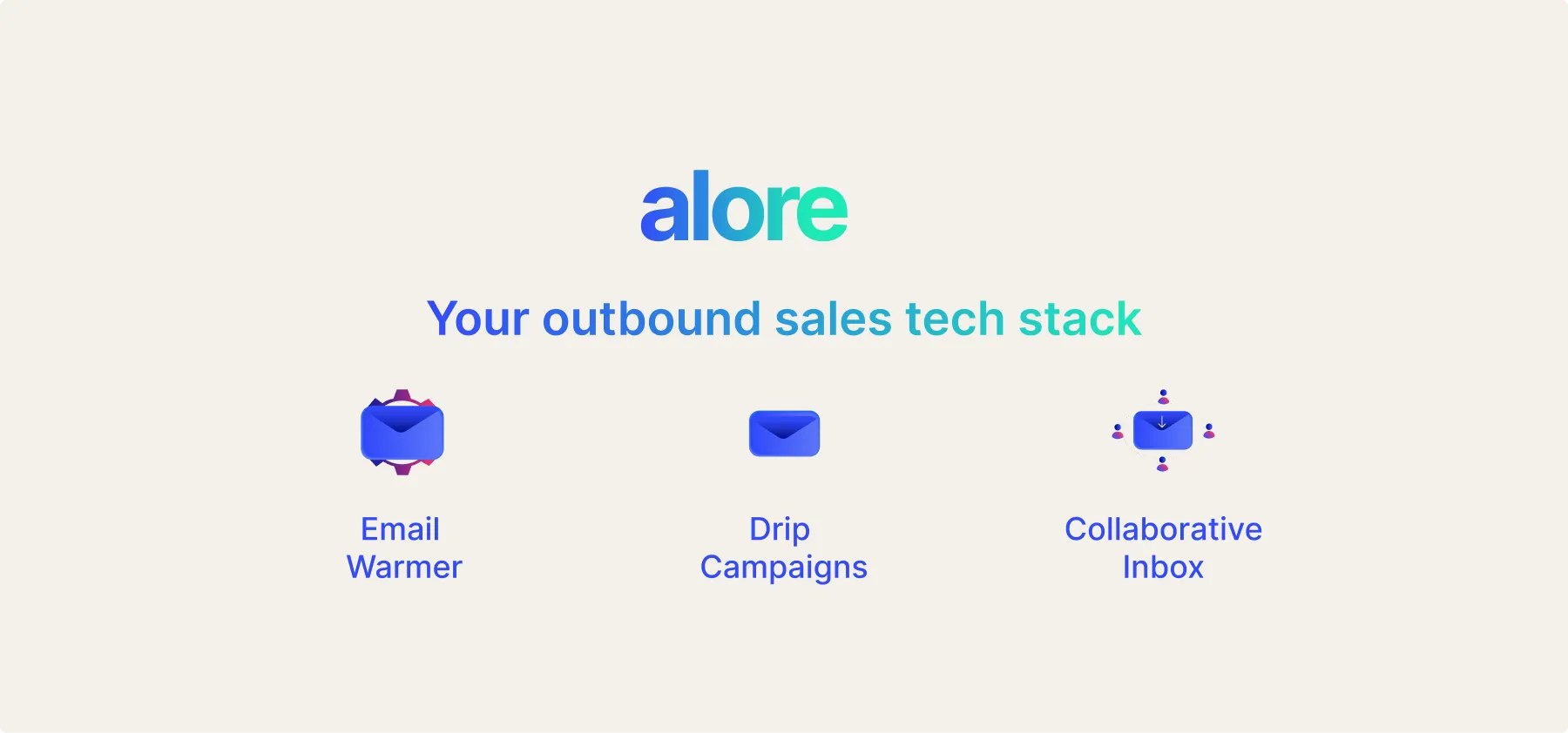
Alore is a comprehensive platform designed to streamline lead generation tools and email campaign management. It helps businesses connect with their target audience effectively by automating email warm-ups, drip campaigns, and performance tracking.
Key Features of Alore:
1. Email Warm-Up Automation
- Custom Warm-Up Settings: Adjust email volume daily for a natural engagement pattern.
- Email Signature Personalization: Keep your branding consistent.
- Detailed Metrics: Track open rates, reply rates, and spam protection.
2. Drip Campaign Manager
- Campaign Categories: Organize campaigns for marketing, consulting, or IT services.
- Custom Sequences: Create personalized email series using placeholders (e.g., {{firstName}}).
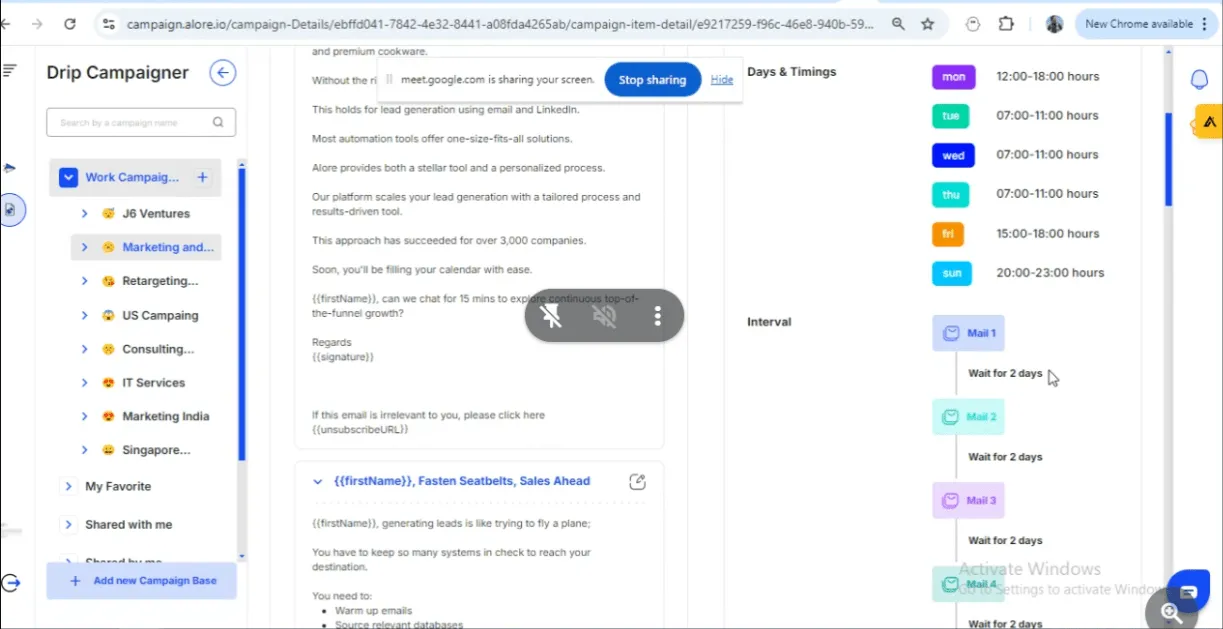
3. Performance Analytics
- Visual Dashboards: Monitor open, reply, and bounce rates through charts.
- Real-Time Updates: Get instant insights on campaign progress.
4. Mail Integration
- Multiple Account Management: Distribute emails across accounts.
- Time Zone Scheduling: Send emails at optimal times for global audiences.
5. Domain Health Monitoring
- Domain Check: Ensure email deliverability with domain age, SSL, and DNS checks.
- Warnings & Alerts: Identify and resolve DMARC or SPF issues.
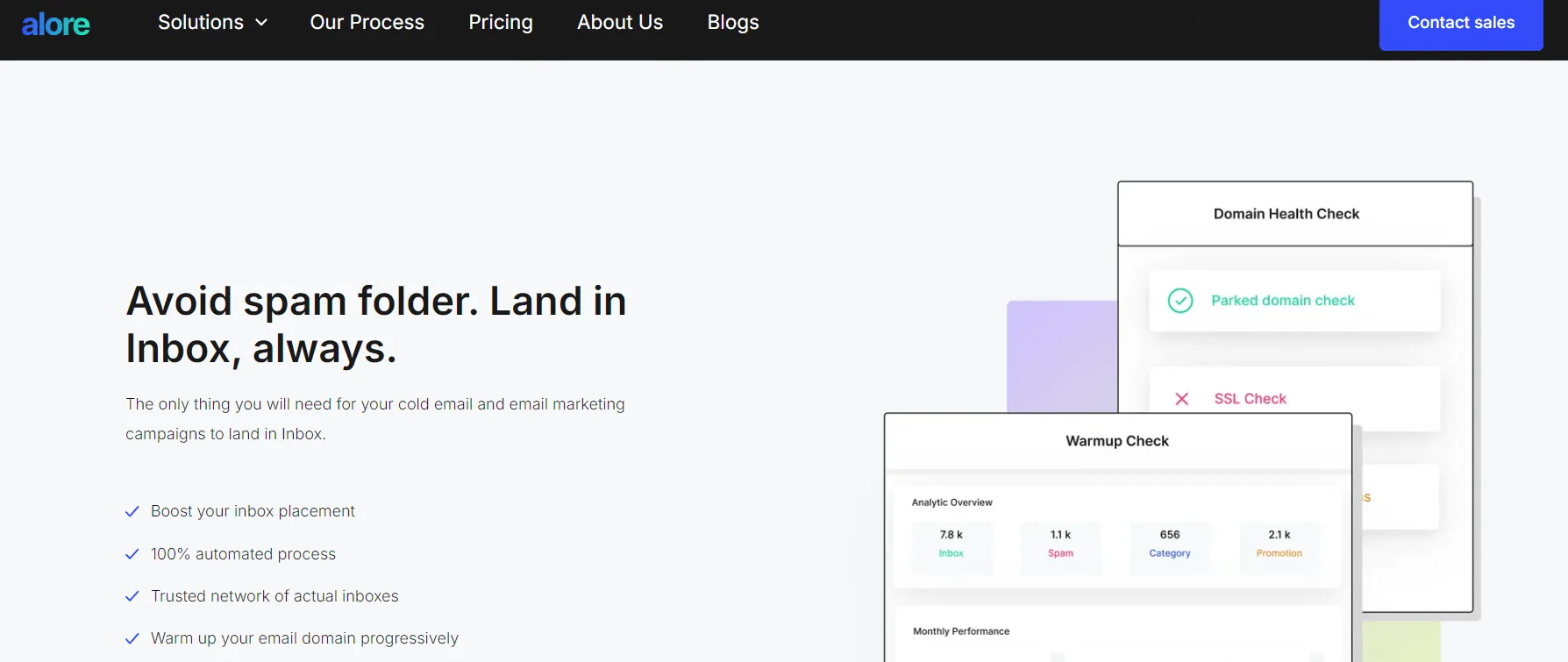
How to Use:
1. Set Up Your Account: Integrate your email accounts. Import your lead database, including names, emails, and contact details.
2. Design Campaigns: Select your target audience. Create personalized drip campaigns with automated follow-ups.
3. Monitor Results: Use visual graphs to analyze metrics. Adjust email volume and schedule based on performance.
Pricing & Plans: Alore offers flexible pricing to suit various business needs:
- Starter Plan: $19/month. Includes free email verification, unlimited connected email accounts, up to 5 domains for warming up, 1,000 uploaded accounts, and a 5,000 monthly email volume.
- Professional Plan: $49/month. Offers enhanced features suitable for growing teams.
- Expert Plan: $149/month. Provides all Professional features with the ability to connect unlimited unique domains for warming up, 100,000 uploaded accounts, and a monthly email volume of 500,000.
G2 Rating: Alore is highly rated for its user-friendly interface and robust features, scoring an average of 4.5 out of 5 stars on G2.
Pros:
- Easy-to-use dashboard.
- Comprehensive email analytics.
- Flexible scheduling and automation.
Cons:
- Requires learning time for advanced settings.
- Best suited for mid-to-large businesses.
Conclusion
Lead generation is essential for business growth. By using the right tools, strategies, and methods like content marketing, social media, and lead magnets, you can attract qualified leads. Focus on your target audience, measure results, and keep optimizing your marketing efforts throughout. Start now to see lasting success in generating leads!





